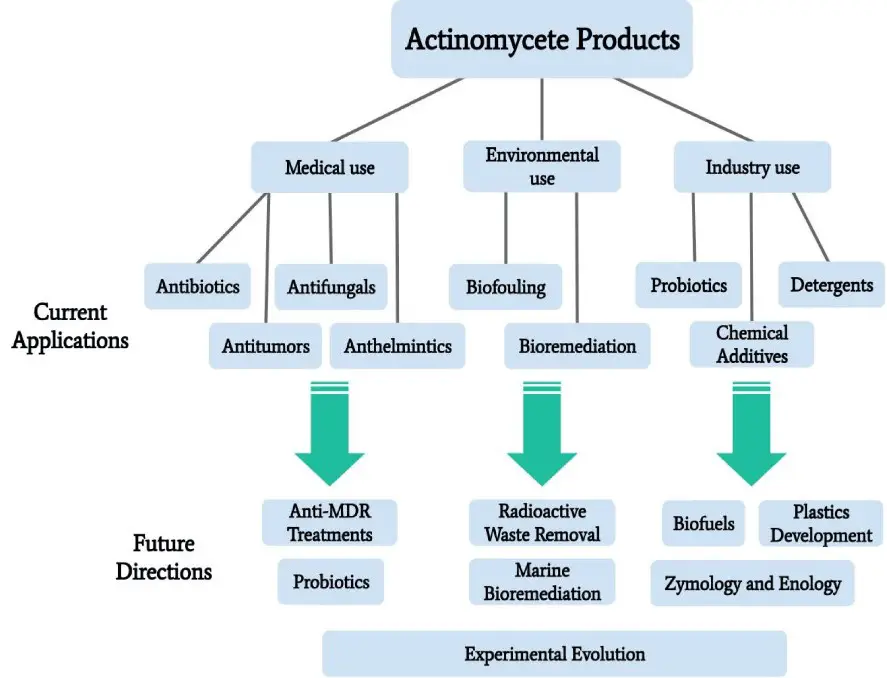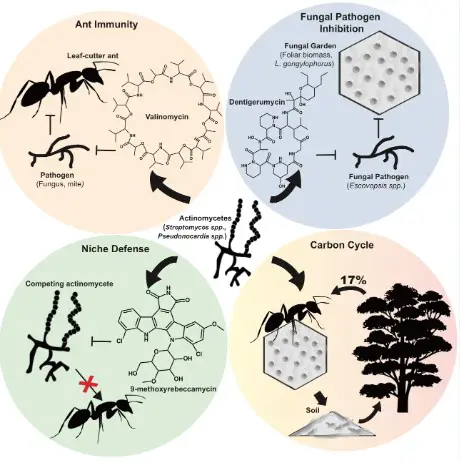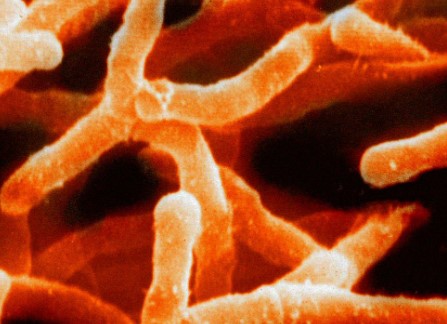The distinction between Actinomyces and Actinomycetes represents a fascinating facet of microbiology that underscores the complexity and diversity of microbial life. Both terms refer to groups of bacteria that share certain features, such as the ability to form filamentous structures, yet they occupy different roles in environmental and medical contexts. This differentiation not only highlights the intricacies of bacterial taxonomy but also underscores the importance of precise scientific classification in understanding the natural world.
Actinomyces and Actinomycetes differ primarily in their taxonomy, habitat, and role in human health. Actinomyces is a genus of bacteria known mainly for its pathogenic species that can cause infections in humans and animals, while Actinomycetes refers to a broader group of filamentous bacteria, many of which are found in soil and are significant for their ability to decompose organic substances and produce antibiotics.
With their capacity to impact both the environment and human health significantly, these bacteria are subjects of intense study. Actinomyces species are investigated for their clinical implications, whereas Actinomycetes are explored for their potential in antibiotic production and environmental conservation. The exploration of these organisms not only aids in medical advancements but also contributes to our understanding of microbial ecosystems and their functions.

Definitions
Actinomyces
Basic Characteristics
Actinomyces are Gram-positive bacteria, distinguished by their ability to form long, branching filaments. These organisms are part of the Actinobacteria phylum, which is known for its complex and diverse members. Actinomyces species are facultatively anaerobic, meaning they can survive in both the presence and absence of oxygen, making them versatile in various environments.
Habitat and Ecology
Actinomyces species are commonly found in the oral cavity and gastrointestinal tract of humans and animals. They contribute to the normal microbial flora but can cause disease if they penetrate the body’s barriers, such as damaged mucous membranes or tissues. In the environment, they are present in soil, playing a role in decomposing organic matter.
Actinomycetes
Core Features
Actinomycetes represent a broader group of Gram-positive bacteria with high G+C content in their DNA. These bacteria are notable for their filamentous growth, resembling fungi. Actinomycetes are aerobic, thriving in oxygen-rich environments. They are prolific antibiotic producers, with many species synthesized medically important antibiotics.
Environmental Presence
Found predominantly in soil, Actinomycetes play a critical role in decomposing organic compounds, including cellulose and chitin. This decomposition process is vital for nutrient cycling and soil health. Actinomycetes are also found in freshwater and marine habitats, contributing to the breakdown of organic materials.
Classification and Taxonomy
Actinomyces
Family and Genus
Actinomyces is classified within the Actinomycetaceae family of the Actinobacteria phylum. This genus encompasses several species, with Actinomyces israelii being a notable pathogen responsible for human actinomycosis.
Key Species
- Actinomyces israelii: Known for causing human actinomycosis.
- Actinomyces viscosus: Associated with oral and dental infections.
Actinomycetes
Broader Classification
Actinomycetes span across several families within the Actinobacteria phylum. Unlike Actinomyces, which refers to a specific genus, Actinomycetes include many genera, reflecting their diverse roles and habitats.
Notable Genera
- Streptomyces: The most significant antibiotic producers.
- Nocardia: Known for causing respiratory and cutaneous diseases.
Morphological Differences
Cellular Structure
Actinomyces Features
Actinomyces bacteria have a branching filamentous structure, which can form complex networks. Their cell walls are thick, containing peptidoglycan and teichoic acids, characteristic of Gram-positive bacteria.
Actinomycetes Characteristics
Actinomycetes, while also filamentous, tend to have a more extensive branching network. Their filaments can fragment into spores, a feature not observed in Actinomyces.
Colony Appearance
Actinomyces Colonies
Colonies of Actinomyces on solid media appear ‘molar tooth’ shaped, with a dense center and filamentous periphery. They are typically not pigmented.
Actinomycetes Growth Patterns
Actinomycetes colonies exhibit diverse appearances, often forming aerial mycelia that can produce pigments, leading to variously colored colonies. Their growth can be powdery, velvety, or even resemble small mounds, depending on the species.

Genetic and Biochemical Traits
Genomic Insights
Actinomyces DNA
Actinomyces species are characterized by their complex genomes, which harbor a significant amount of genetic information. This complexity enables them to adapt to various environments, including those within the human body. Their DNA is rich in GC content, a feature common among Actinobacteria, providing them stability and resilience against harsh conditions.
Actinomycetes Genetic Makeup
Actinomycetes, especially the genus Streptomyces, possess one of the largest bacterial genomes. This expansive genetic material encodes a vast array of enzymes, regulatory proteins, and secondary metabolites. Such diversity is the reason behind their capability to produce over two-thirds of the naturally derived antibiotics used in medicine today.
Metabolic Pathways
Actinomyces Metabolism
The metabolic pathways of Actinomyces are finely tuned to their anaerobic or microaerophilic lifestyles. They can ferment sugars to lactic acid, a process beneficial in oral environments but also a contributing factor to dental caries. Their metabolism supports their survival in mucosal and dental plaque communities, where they play roles in both health and disease.
Actinomycetes Biochemical Activities
Actinomycetes are renowned for their metabolic versatility, capable of decomposing a wide range of organic substances. Their biochemical activities include breaking down complex polymers like cellulose, lignin, and chitin, making them crucial for soil health and the global carbon cycle. This group’s ability to produce novel compounds has vast implications in pharmaceuticals, including antibiotics, antifungals, and anticancer agents.
Role in Human Health
Actinomyces
Pathogenic Species
While many Actinomyces species are harmless, several are known pathogens. Actinomyces israelii, for instance, causes actinomycosis, leading to abscess formation and fibrosis. This condition primarily affects the oral and facial regions but can spread, necessitating prolonged antibiotic therapy.
Clinical Manifestations
Actinomycosis presents with swelling, pain, and draining sinuses, often mistaken for malignancies due to its chronic nature. Early diagnosis and treatment are critical to prevent severe complications, highlighting the need for awareness among healthcare providers and the public.
Actinomycetes
Antibiotic Production
The role of Actinomycetes in antibiotic production cannot be overstated. Streptomyces alone is responsible for the discovery of streptomycin, tetracycline, and erythromycin, among others. Their natural ability to produce these compounds is harnessed in industrial settings to develop drugs that combat a wide range of bacterial infections.
Therapeutic Applications
Beyond antibiotics, Actinomycetes-derived compounds are explored for their potential in cancer therapy, immunosuppression, and treating fungal infections. The ongoing search for new compounds aims to address antibiotic resistance, one of the most pressing health challenges of our time.
Environmental Impact
Ecological Contributions
Actinomyces in Soil Health
In the soil, Actinomyces contribute to the breakdown of organic matter, recycling nutrients essential for plant growth. Their presence supports the soil structure and fertility, underlining their importance in ecosystem dynamics.
Actinomycetes in Biodegradation
Actinomycetes play a pivotal role in biodegradation, particularly in decomposing recalcitrant compounds like plastics and pesticides. Their enzymatic capabilities are leveraged in bioremediation efforts, offering sustainable solutions to pollution and waste management challenges.
Industrial Uses
Actinomyces in Biotechnology
The versatility of Actinomyces extends to biotechnology, where they are used in enzyme production and waste treatment processes. Their enzymes have applications in food, pharmaceutical, and textile industries, showcasing the breadth of their utility.
Actinomycetes in Agriculture
Actinomycetes enhance agricultural productivity through biofertilizers and biopesticides. They improve soil health, promote plant growth, and provide a natural defense against pests and diseases, reducing the reliance on chemical inputs.
Research and Technological Advances
New Discoveries
Recent Actinomyces Studies
Ongoing research into Actinomyces is unveiling their complex interactions within the microbiome and potential roles in immunomodulation. Understanding these dynamics opens avenues for novel therapies targeting microbial imbalances and chronic diseases.
Actinomycetes Research Frontiers
The exploration of Actinomycetes has led to the discovery of previously unknown compounds with significant medical potential. Advances in genomic and bioinformatic technologies are accelerating the identification of new species and bioactive molecules, promising a new era of drug development.
Technological Applications
Biomedical Engineering
In biomedical engineering, Actinomyces and Actinomycetes are studied for their potential in tissue engineering and regenerative medicine. Their natural products can serve as scaffolds or bioactive agents, promoting healing and tissue regeneration.
Environmental Biotechnology
Actinomyces and Actinomycetes are at the forefront of environmental biotechnology, offering solutions for sustainable agriculture, waste treatment, and bioremediation. Their applications in these areas exemplify the integration of microbiological knowledge with engineering principles to address environmental and societal challenges.
Frequently Asked Questions
What are Actinomyces?
Actinomyces are a genus of Gram-positive bacteria that form branching filaments. They are known primarily for their role in causing diseases such as actinomycosis in humans and animals. These bacteria thrive in anaerobic or microaerophilic conditions and are often found in the oral cavity and other parts of the human body, contributing to dental and periodontal diseases.
How do Actinomycetes benefit the environment?
Actinomycetes play a crucial role in soil health and ecology by breaking down complex organic materials, thus facilitating nutrient recycling. Their ability to produce a wide array of enzymes makes them effective decomposers, which enhances soil fertility and structure. Additionally, some Actinomycetes species are known for their capacity to produce antibiotics, which can suppress soil-borne pathogens, further supporting plant health.
Can Actinomyces cause diseases in humans?
Yes, certain species of Actinomyces are pathogenic to humans and can cause actinomycosis, a condition characterized by the formation of painful abscesses in the mouth, lungs, or gastrointestinal tract. The disease often develops after trauma to the mucous membranes, allowing the bacteria to invade deep tissues. Treatment typically involves prolonged courses of antibiotics to eradicate the infection.
What distinguishes Actinomyces from Actinomycetes?
The primary distinction between Actinomyces and Actinomycetes lies in their classification and biological roles. Actinomyces is a specific genus within the Actinomycetales order, known for its pathogenic species affecting humans and animals. In contrast, Actinomycetes is a broader term for a class of Gram-positive bacteria that includes numerous genera, many of which are found in soil and are essential for decomposing organic matter and producing antibiotics.
Conclusion
In conclusion, the differentiation between Actinomyces and Actinomycetes encapsulates the vast and intricate world of microbiology, where even closely related organisms can have profoundly different impacts on human health and environmental sustainability. These bacteria not only contribute to the complexity of microbial ecosystems but also offer promising avenues for medical and technological advancements. As research continues to unravel the mysteries of these microorganisms, their potential benefits and challenges to our world become increasingly apparent, showcasing the pivotal role of scientific inquiry in harnessing the power of the microscopic world.
This exploration of Actinomyces and Actinomycetes not only enriches our understanding of microbial diversity but also emphasizes the importance of precise classification in the scientific endeavor to comprehend and utilize the natural world. As we delve deeper into the realm of microbiology, the knowledge gained serves as a cornerstone for future innovations in medicine, agriculture, and environmental management, highlighting the intricate balance between humans and the microscopic entities that share our planet.

